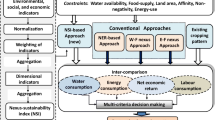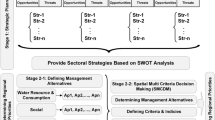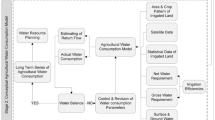Abstract
In 2015, a “Post-2015 Development Agenda” is defined for future global developments in water management. The proposed goal is referred to as SDG’s or Sustainable Development Goals, which will balance the economic, social and environmental dimensions of sustainable development with a strong linkage between environment and socio-economic goals. One of the major concepts of SDG’s is water security, which is the basic element of the Global Goal on Water, now defined as: “Securing Sustainable Water for All”. The proposal for a Global Goal for Water is associated with targets and indicators to help countries reach the goal by 2030. Among the five main targets specified, two major ones emphasize “water allocation” as an important support of water security, particularly in conditions of water security. This paper focuses on this latter issue in the case of water scarce Gediz Basin along the Aegean coast of Turkey, where irrigation is the major water consuming activity. In addition to allocation of water among other water use sectors and irrigation, it is important in the basin how irrigation water is allocated to various crops, as previous droughts struck crop yields the most. Thus, 16 alternative allocation scenarios are developed to assess the crop yield produced by each scenario. These alternatives are represented by social, economic and environmental indicators as criteria for selection the most favorable alternative. The selection is realized by Multi Criteria Analysis (MCA) methodology, using the Reference Point Approach (RPA). In terms of methodology, presented paper shows that RPA is a powerful tool to guide engineers and decision makers to rationally select among several possible alternatives in water allocation.






Similar content being viewed by others
References
Allen RG, Pereira LS, Raes D, Smith M (1998) Crop evapotranspiration – guidelines for computing crop water requirements. FAO irrigation and drainage paper 56. FAO, Rome
Al-Omari A, Al-Quraan S, Al-Salihi A, Abdulla F (2009) A water management support system for Amman Zarga Basin in Jordan. Water Resour Manag 23(15):3165–3189
Brouwer R, Hofkes M (2008) Integrated hydro-economic modelling: approaches, key issues and future research directions. Ecol Econ 66(1):16–22
Cetinkaya CP, Harmancioglu NB (2014) Reduction of streamflow monitoring networks by a reference point approach. J Hydrol 512:263–273
Chen Y, Zhang D, Sun Y, Liu X, Wang N, Savenije HHG (2005) Water demand management: a case study of the Heihe River Basin in China. Phys Chem Earth 30(6–7):408–419
Doorenbos J, Kassam AH (1979) Yield response to water. FAO Irrigation and Drainage Paper 33
DSI (1996) Evaluation report of irrigation facilities operated and endorsed by DSI of year 1995. DSI, Ankara, pp 241–247
Figueira JR, Liefooghe A, Talbi EG, Wierzbicki AP (2010) A parallel multiple reference point approach for multi-objective optimization. Eur J Oper Res 205:390–400
Guimarães LT, Magrini A (2008) A proposal of indicators for sustainable development in the management of river basins. Water Resour Manag 22(9):1191–1202
Hajkowicz S, Collins K (2007) A review of multiple criteria analysis for water resource planning and management. Water Resour Manag 21:1553–1566
Hammouri NA (2009) Assessment of climate change impacts of water resources in Jordan. International Exhibition on Green Energy & Sustainability for Arid Regions & Mediterranean Countries (ICEGES)
Harmancioglu NB (2004) Indicators for sustainable management of water resources, In: Proceedings of IV, National Hydrology Congress, ITU, İstanbul, pp 9–18
Harmancioglu NB (2017) Overview of water policy developments: pre- and post- 2015 development agenda. Water Resour Manag 31(10):3001–3021
Harmancioglu NB, Cetinkaya CP (2002) Resource management in water short basins. In: Al-Rashed M, Singh VP, Sherif MM (eds) Water resources development and management, vol 4. Swets & Zeitlinger, Lisse, pp 467–477
Harmancioglu NB, Yilmaz B (2010) Multi-criteria decision making for water resources management: a case study of the Gediz river basin, Turkey. Water SA 36(5):563–576
Harou JJ, Pulido-Velazquez M, Rosenberg DE, Medellín-Azuara J, Lund JR, Howitt RE (2009) Hydro-economic models: concepts, design, applications, and future prospects. J Hydrol 375(3–4):627–643
Hwang CL, Yoon K (1981) Multiple-attribute decision making. Springer-Verlag, Berlin
Jeong CS, Heo JH, Bae DH, Georgakakos GP (2005) Utility of high-resolution climate model simulations for water resources prediction over Korean Peninsula: a sensitivity study. Hydrol Sci J 50(1):139–153
Koch H, Grünewald U (2009) A comparison of modelling systems for the development and revision of water resources management plans. Water Resour Manag 23:1403–1422
Lévite H, Sally H, Cour J (2002) Water demand management scenarios in a water stressed basin in South Africa. 3rd WARSFA/ Waternet Symposium
Lévite H, Sally H, Cour J (2003) Testing water demand management scenarios in a water-stressed basin in South Africa: application of the WEAP model. Phys Chem Earth 28(20&27):779–786
Loukas A, Mylopoulos N, Vasiliades L (2007) A modeling system for the evaluation of water resources management strategies in Thessaly, Greece. Water Resour Manag 21(10):1673–1702
Pallottino S, Sechi GM, Zuddas P (2005) A DSS for water resources management under uncertainty by scenario analysis. Environ Model Softw 20(20):1031–1042
Raskin P, Hansen E, Zhu Z (1992) Simulation of water supply and demand in the Aral Sea region. Water Int 17:55–67
Srdjevic B, Medeiros YDP, Faria AS (2004) An objective multi-criteria evaluation of water management scenarios. Water Resour Manag 18:35–54
Strzepek KM, Major DC, Rosenzweig C, Iglesias A, Yates DN, Holt A, Hillel D (1999) New methods of modelling water availability for agriculture under climate change: the US Cornbelt. J Am Water Resour Assoc (JAWRA) 35(6):1635–1655
Triantaphyllou E (2000) Multi-criteria decision making methods: a comperative study. In: Parlos P (ed) Kluwer Academic Publishers, Dordrect. https://link.springer.com/content/pdf/bfm%3A978-1-4757-3157-6%2F1.pdf
UNESCO (2016) Key outcomes of the inception workshop: addressing water security. Climate impacts and adaptation responses in Africa, Americas and Asia. In: Muir MAK, Avila B, Mishra A, Verbist K (eds) Flanders (SC-2015/WS/31). http://unesdoc.unesco.org/images/0024/002439/243994E.pdf
Varis O, Kajander T, Lemmela R (2004) Climate and water: from climate models to water resources management and vice versa. Climate Change 66(3):321–344
Vujic B, Srdjevic Z, Srdjevic B (2017) Reference point approach for multi-objective assessment and reduction of ground level O3 air quality monitoring network in Vojvodina province, Serbia. Environ Model Assess 22:491–501
Walmsley JJ (2002) Framework for measuring sustainable development in catchment systems. Environ Manag 29(2):195–206
Wierzbicki AP (1980) The use of reference objectives in multiobjective optimisation. In: Fandel G, Gal T (eds) MCDM theory and application, proceedings, number 177 of lecture notes in economics and mathematical systems, Hagen. Springer, Verlag, pp 468–486
Wierzbicki AP (1999) Reference point approaches. In: Gal T, Stewart T, Hanne T (eds) Multicriteria decision making: advances in MCDM models, algorithms, theory, and applications. Kluwer Academic Publishers, Boston, pp 9,1–9,39
Yilmaz B, Harmancioglu NB (2010) An indicator based assessment for water resources management in Gediz River Basin, Turkey. Water Resour Manag 24(15):4359–4379
Author information
Authors and Affiliations
Corresponding author
Ethics declarations
Conflict of Interest
None.
Rights and permissions
About this article
Cite this article
Cetinkaya, C.P., Gunacti, M.C. Multi-Criteria Analysis of Water Allocation Scenarios in a Water Scarce Basin. Water Resour Manage 32, 2867–2884 (2018). https://doi.org/10.1007/s11269-018-1963-z
Received:
Accepted:
Published:
Issue Date:
DOI: https://doi.org/10.1007/s11269-018-1963-z




